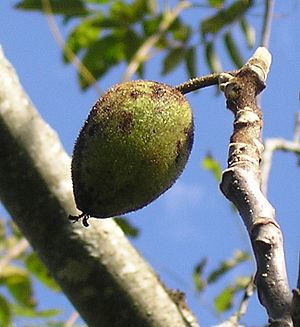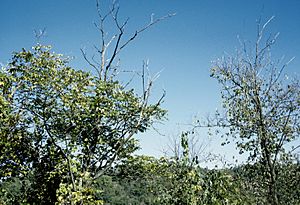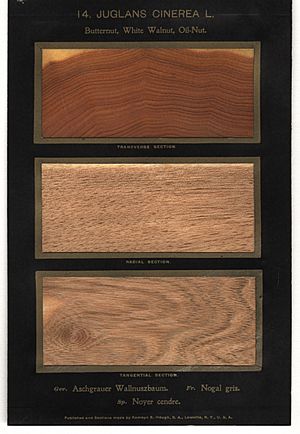Butternut facts for kids
Quick facts for kids Butternut |
|
|---|---|
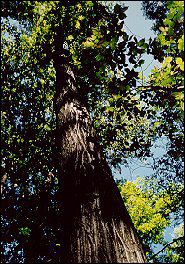 |
|
| A mature butternut tree | |
| Conservation status | |
| Scientific classification | |
| Genus: |
Juglans
|
| Species: |
cinerea
|
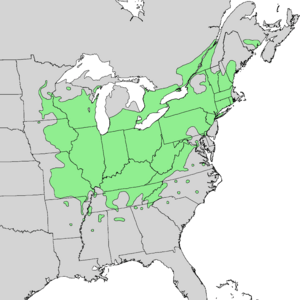 |
|
| Natural range | |
| Synonyms | |
|
|
The butternut tree, also called white walnut, is a type of walnut tree. It grows naturally in the eastern United States and southeastern Canada.
Contents
Where Do Butternut Trees Grow?
Butternut trees are found from New Brunswick in the east, all the way to Minnesota in the west. They grow south into northern Alabama and northern Arkansas. Butternuts prefer cooler weather than black walnuts. They can grow in places like Wisconsin and Minnesota, where the growing season is too short for black walnuts.
What Does a Butternut Tree Look Like?
The butternut tree is a deciduous tree, meaning it loses its leaves each fall. It usually grows up to 20 meters (65 feet) tall. Sometimes, it can reach 40 meters (130 feet). Butternut trees grow slowly and usually live less than 75 years. Their trunks can be 40 to 80 centimeters (16 to 31 inches) wide. The bark is light gray.
Butternut Leaves
The leaves grow in an alternate pattern along the branch. Each leaf is long, about 40 to 70 centimeters (16 to 28 inches). They have 11 to 17 smaller leaflets. Each leaflet is 5 to 10 centimeters (2 to 4 inches) long and 3 to 5 centimeters (1 to 2 inches) wide. The leaves have an odd number of leaflets, with one at the very end. The whole leaf feels soft and fuzzy. It is a brighter, more yellow-green than many other tree leaves.
Butternut Flowers and Fruit
Butternut trees know when to grow new leaves in spring based on how long the daylight lasts. This can change by a month depending on where the tree is. Leaves fall early in autumn when daylight gets shorter.
Butternut trees have both male and female flowers on the same tree. Male flowers are small, yellow-green catkins. Female flowers are short spikes with a light pink stigma. Usually, the male and female flowers on one tree do not open at the exact same time.
The fruit is a lemon-shaped nut. It grows in bunches of two to six. The nut is oval-shaped, about 3 to 6 centimeters (1 to 2.5 inches) long and 2 to 4 centimeters (0.8 to 1.5 inches) wide. Before it is ready in mid-autumn, it is covered by a green husk.
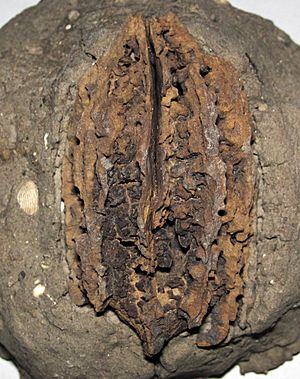
Where Butternuts Like to Grow
Butternut trees grow best near streams and in soil that drains water well. They do not do well in dry, hard, or poor soils. However, they can grow better than black walnut trees in dry, rocky soils, especially those with limestone. Butternuts are often found in rocky areas of New England.
You can often find butternut trees in sheltered areas, on stream banks, and on slopes. They grow at higher elevations than black walnuts, up to 1500 meters (4,900 feet) in places like Virginia. Many animals eat the nuts.
Trees That Grow With Butternuts
Butternut trees often grow with many other tree types in mixed forests. They are found with trees like basswood, black cherry, beech, black walnut, elm, hemlock, hickory, oak, red maple, sugar maple, yellow poplar, white ash, and yellow birch.
In the northeastern part of their range, they are often found with sweet birch. In the northern part, they sometimes grow with white pine. Usually, there are only a few butternut trees in a forest. In the past, states like West Virginia and Wisconsin produced a lot of butternut wood.
Sunlight Needs
Young butternut trees can handle some shade from the sides. But they need lots of sunlight from above to grow well. They are known as "intolerant of shade." This means they need to be taller than other trees to thrive.
Butternut Tree Diseases
Butternut Canker
The most serious disease for butternut trees is called butternut canker. This disease is caused by a fungus. The fungus spreads easily, so even trees growing alone can get sick.
Butternut canker arrived in the United States around the early 1900s. It came on Japanese walnut trees brought from other countries.
Signs of the disease include branches and stems dying. First, sores (cankers) appear on lower branches. Rainwater then spreads spores from these sick branches to the tree's main trunk. Cankers on the trunk can kill the tree's top within a few years. Trees that are completely alone seem to handle the fungus better than those in crowded forests. In some areas, 90% of butternut trees have died. The disease has almost wiped out butternuts in North and South Carolina. Black walnut trees seem to be able to resist this disease.
Hybrid Trees
Butternut trees can mix with Japanese walnut trees to create a hybrid called a 'buartnut'. These buartnut trees are resistant to the canker disease. Scientists are now trying to cross butternuts with buartnuts. This creates 'butter-buarts' which have more butternut traits but keep the disease resistance. Most butternut trees planted in yards are actually buartnuts.
Other Problems
Butternut trees can also get a disease called bunch disease. This causes yellow "witches' brooms" where many small branches grow from one spot. Infected branches can die in the winter. Very sick trees might eventually die. Butternuts seem to get this disease more easily than black walnuts.
Birds like the common grackle can destroy young butternut fruits. This makes them a pest when there are many birds.
Butternut trees are also easily damaged by fire. While they usually stand strong in wind, storms can often break their branches.
Protecting Butternut Trees
The butternut tree is not listed as threatened by the US government. However, it is a "Special Concern" in Kentucky, "Exploitably Vulnerable" in New York, and "Threatened" in Tennessee.
In Canada, the butternut was added to the endangered species list in 2005.
Efforts are being made to save the species. For example, in Huntingburg, Indiana, about 60 butternut trees were planted in 2012. This is part of a bigger project to help the species and breed trees that can resist the canker disease.
Famous Butternut Trees
The largest butternut tree in America is in Oneida, New York. In 2016, its trunk was 288 inches (7.3 meters) around. It was 67 feet (20 meters) tall, and its branches spread 88 feet (27 meters) wide.
In the book Little Men (1871) by Louisa May Alcott, two young boys have a funny fight with squirrels over collecting butternuts.
The Bush butternut tree in Tumwater, Washington, was planted by George Bush in 1845. He brought it from Missouri. This tree is still alive today!
How People Use Butternut Trees
The nuts of the butternut tree are good to eat. Native Americans used to make oil from them for different purposes. The green husks around the nuts can be used to make a natural yellow-orange dye.
Butternut Wood
Butternut wood is light and takes polish well. It resists rot, but it is much softer than black walnut wood. When oiled, the wood's grain often looks very bright. It is often used to make furniture and is a favorite for woodcarvers.
Fabric Dye
The bark and nut husks of butternut trees were once used to dye cloth. They could make colors from light yellow to dark brown. To get darker colors, the bark was boiled. This dye was mostly used at home, not for commercial products.
During the mid-1800s, people in places like southern Illinois and Indiana were sometimes called "butternuts." This was because some wore homespun cloth dyed with butternut. Later, during the American Civil War, some Confederate soldiers were called "butternuts." Their gray uniforms sometimes faded to a tan or light brown. It is also possible that some soldiers wore cloth dyed with butternut. This nickname came from the color of their uniforms and the idea of homemade clothing.
Fishing
Historically, crushed butternut fruits could be used to stun fish. However, this practice is against the law in most places today.



